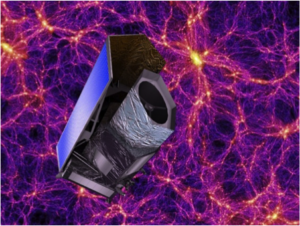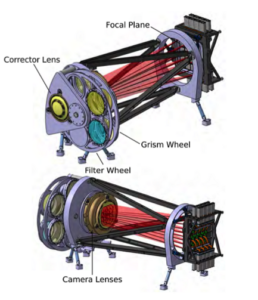Euclid is a European mission to understand dark energy where LAM plays a central role.
-
Understanding dark energy
 The Universe is apparently accelerating its expansion.
The Universe is apparently accelerating its expansion.This requires a tremendous energy, which has been called “dark energy” : its effects are measured but it is “dark” as today there is no firm evidence upon its nature.
Either we are faced with a new type of particle or one of the fundamental laws of Physics, Gravity, needs to be modified. Understanding the nature of Dark Energy is one of the major challenges of contemporary Physics. As the effects of dark energy are most visible on very large scales, it can be tested using the distribution of ordinary and dark matter in the Universe. Astrophysics, and particularly Cosmology, provides the most relevant methods to test this new form of energy.
The properties of Dark Energy can be measured by looking at how galaxies are distributed in space at different epochs along the life of the Universe, and by measuring deformations of space-time produced by gravitational lensing.The European scientific community has designed the Euclid space mission to survey most of the sky, selected for implementation by ESA in 2011. A total of 15000 square degrees will be surveyed, to obtain detailed images of more than 2 billion galaxies, and spectroscopy of more than 50 million of them to obtain the most detailed 3D map of the universe ever produced, looking back in time about 10 billion years. Euclid will be the most efficient experiment dedicated to Dark Energy in the next decade, providing extremely accurate measurements on scales never attainted before.
-
A space telescope with superb imaging and spectroscopic capabilities
The Euclid concept is based on a 1.2m telescope with 2 instruments. The NISP, the Near-Infrared Spectrograph and Photometer, will provide spectroscopy and photometry in the near-infrared domain. The VIS is a visible imager based on a large CCD array working in the visible domain.
-
The NISP instrument at LAM
 NISP is a wide field spectrograph working in the near-infrared (figure). It is designed to follow the signatures of chemical elements like Hydrogen (the H line) in galaxies out to a redshift z=2, corresponding to a time when the Universe was about 10 billion years old. These spectral signatures are used to compute the redshift, related to the distance, of these galaxies. NISP will then produce a very accurate map of the distribution of galaxies in 3D space at all epochs across these 10 billion years of evolution. The NISP has been developed under the leadership of LAM with CNES. The design has been done in great part at LAM, and the instrument was integrated and tested in the LAM Plateforms. The large ERIOS curve has been particularly useful to test NISP under the stringent space conditions.
NISP is a wide field spectrograph working in the near-infrared (figure). It is designed to follow the signatures of chemical elements like Hydrogen (the H line) in galaxies out to a redshift z=2, corresponding to a time when the Universe was about 10 billion years old. These spectral signatures are used to compute the redshift, related to the distance, of these galaxies. NISP will then produce a very accurate map of the distribution of galaxies in 3D space at all epochs across these 10 billion years of evolution. The NISP has been developed under the leadership of LAM with CNES. The design has been done in great part at LAM, and the instrument was integrated and tested in the LAM Plateforms. The large ERIOS curve has been particularly useful to test NISP under the stringent space conditions.More on Euclid :
– Euclid Consortium page : www.euclid-ec.org
– Euclid page at ESA : www.sci.esa.int/euclid/
– Euclid page at CNES : www.euclid.cnes.fr




